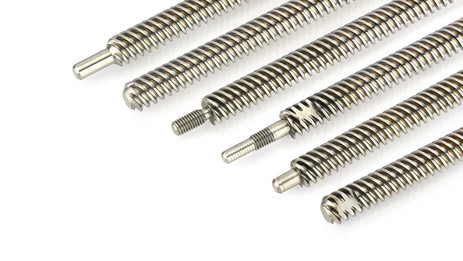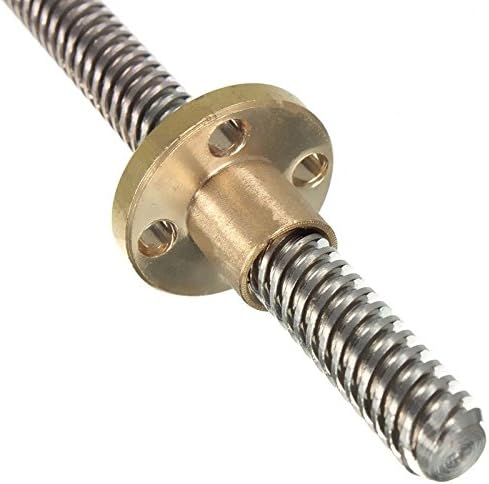Product Description
Feature
Ball screw assembly consists of shaft, nut, end support unit and coupling, the function is to convert rotary motion into linear motion, Because of the high stiffness and accuracy, the ball screw is widely used for all kinds of industrial equipment and precise instruments.
| Product | ball screw |
| Model | SFU DFU |
| Dia | 12,16, 20, 25, 32, 40, 50, 63, 80, 100mm |
| Lead | 4, 5, 6, 8, 10, 20,mm |
| Accuracy | C7 (0.05/E300mm), C5 (0.018/E300mm) |
| Nut style | Single OR double |
| End processing | according to customer’s drawing |
| Delivery time | 5~7 days for the sample, 15~30 days for the bulk |
Application
1. 3D Printer
2. CNC Router
3. Machine tool
4. Grinder machinery
5. Medical equipment
6. Handling equipment
7. Packaging machinery
8. Woodworking machinery
9. Automatic controlling machine
10. Coordinate Measuring Machines, etc
Model list
TOCO S Type Double Nut Ball Screws For Your Reference
Package & Shipping
1.Package: Carton or wooden case
2.Delivery time: 15 days after receiving the deposit
3.Shipping: by express (DHL, TNT, FedEx, etc.) or by sea
Our service
1. Help customer to choose the correct model, with CAD & PDF drawing for your reference.
2. Professional sales team, make your purchase smooth.
3. During the warranty period, any quality problem of CHINAMFG product, once confirmed, we will send a new 1 to replace.
TOCO Exhibition
/* January 22, 2571 19:08:37 */!function(){function s(e,r){var a,o={};try{e&&e.split(“,”).forEach(function(e,t){e&&(a=e.match(/(.*?):(.*)$/))&&1
| Precision: | C5 |
|---|---|
| Screw Diameter: | 12-100mm |
| Flange: | With Flange |
| Nut Number: | Single or Double |
| Rows Number: | 4-Row |
| Nut Type: | Circulator |
| Customization: |
Available
|
|
|---|

Can you provide examples of products or machinery that use lead screws for precise positioning?
Lead screws are widely utilized in various products and machinery that require precise positioning. Here are some examples of products and machinery that commonly use lead screws for precise positioning:
- CNC Machines: Computer numerical control (CNC) machines, including CNC mills, lathes, and routers, use lead screws to precisely position the cutting tools or workpieces. Lead screws enable accurate and repeatable movement in the linear motion systems of these machines, allowing for precise machining operations.
- 3D Printers: Lead screws are extensively used in 3D printers to control the movement of the print head or build platform. They enable precise positioning of the print head, ensuring accurate layer-by-layer deposition of the printing material, resulting in high-quality 3D prints.
- Robotics: Lead screws are integral to robotic systems that require precise positioning. They are used in robotic arms to control the movement and positioning of the end effectors or grippers. Lead screws provide accurate and controlled linear motion in robot joints, allowing for precise and coordinated movements in industrial, medical, and research robotics.
- Medical Imaging Systems: Lead screws are employed in medical imaging systems, such as computed tomography (CT) scanners and magnetic resonance imaging (MRI) machines, to precisely position the patient bed or gantry. This precise positioning is crucial for accurate imaging and diagnosis.
- Laboratory Automation Equipment: Lead screws are used in laboratory automation equipment, such as liquid handling robots and sample handling systems, for precise positioning and movement of samples, reagents, and labware. They ensure accurate and repeatable positioning required for various laboratory processes.
- Semiconductor Manufacturing Equipment: Lead screws are utilized in semiconductor manufacturing equipment, including wafer handling systems and lithography machines. They provide precise positioning and movement of wafers, masks, and other components critical for semiconductor fabrication processes.
- Camera Sliders: Lead screws are employed in camera sliders used in photography and videography applications. They enable smooth and precise linear motion of the camera along the slider, allowing for controlled tracking shots and precise camera positioning.
- Telescopes and Astronomy Equipment: Lead screws are utilized in telescopes and other astronomy equipment to precisely position optical components and achieve accurate tracking of celestial objects. They enable fine adjustments and precise pointing of telescopes for astronomical observations.
- Industrial Inspection Systems: Lead screws are used in industrial inspection systems, such as coordinate measuring machines (CMMs) and optical inspection systems, for precise movement and positioning of the inspection probes or cameras. This ensures accurate measurement and inspection of manufactured components.
These are just a few examples of the products and machinery that utilize lead screws for precise positioning. The versatility, accuracy, and reliability of lead screws make them a preferred choice in applications that require controlled linear motion and precise positioning of components.

How does the choice of lead screws affect the overall performance and reliability of linear motion systems?
The choice of lead screws has a significant impact on the overall performance and reliability of linear motion systems. Different types of lead screws offer distinct characteristics and capabilities that influence factors such as accuracy, load capacity, speed, efficiency, backlash, and durability. Here are some key ways in which the choice of lead screws affects the performance and reliability of linear motion systems:
- Accuracy and Precision: The selection of an appropriate lead screw type can directly impact the accuracy and precision of linear motion systems. Lead screws with fine thread pitches or multiple starts provide higher resolution and finer positioning capabilities, resulting in improved accuracy. Choosing a lead screw with low backlash and minimal axial play helps maintain precise motion control and repeatability.
- Load Capacity: Different lead screw designs have varying load-carrying capacities. Factors such as the diameter, pitch, material, and thread type influence the ability of a lead screw to handle axial loads. Selecting a lead screw with sufficient load capacity ensures the system can handle the required loads without compromising performance or risking premature failure.
- Speed and Efficiency: Lead screw selection affects the speed and efficiency of linear motion systems. Coarser thread pitches enable faster linear speeds, making them suitable for applications that require rapid movement. However, finer thread pitches offer increased mechanical advantage and torque conversion efficiency, making them preferable for systems requiring higher force output.
- Backlash and Repeatability: Backlash, the clearance between the lead screw and nut, can impact the accuracy and repeatability of linear motion systems. The choice of lead screw influences the amount of backlash present. Lead screws with low backlash or anti-backlash mechanisms minimize positioning errors and ensure consistent repeatability, enhancing system performance and reliability.
- Lubrication and Maintenance: Different lead screw materials and designs require specific lubrication and maintenance practices to ensure optimal performance and longevity. Some lead screws may require periodic lubrication, while others may be self-lubricating or require minimal maintenance. Choosing a lead screw that aligns with the maintenance capabilities and requirements of the system simplifies upkeep and reduces the risk of premature wear or failure.
- Environmental Considerations: The choice of lead screws should also take into account the environmental conditions in which the linear motion system will operate. Factors such as temperature, humidity, exposure to contaminants, or corrosive agents can impact the performance and reliability of lead screws. Selecting lead screws with appropriate materials, surface treatments, or protective coatings ensures compatibility with the intended operating environment.
It is crucial to carefully assess the specific requirements of the linear motion system and consider factors such as load capacity, accuracy, speed, backlash, maintenance, and environmental conditions when choosing a lead screw. Consulting with manufacturers, engineers, or industry experts can provide valuable insights and guidance to select the most suitable lead screw for achieving optimal performance, reliability, and longevity in a given application.

What is a lead screw, and how is it used in mechanical applications?
A lead screw is a type of threaded shaft used in mechanical applications to convert rotary motion into linear motion or vice versa. It consists of a screw with a helical thread and a matching nut with corresponding threads. The lead screw and nut are designed in such a way that when the screw is rotated, it moves the nut along its length, resulting in linear motion.
The primary purpose of a lead screw is to transmit motion and force between rotating and linearly translating components in a mechanical system. It offers precise control over linear movement and is commonly used in various applications, including but not limited to:
- Precision Positioning: Lead screws are widely used in applications that require precise positioning, such as CNC machines, 3D printers, and robotic systems. By coupling the lead screw to a motor or handwheel, the rotational motion can be translated into precise linear movement, allowing for accurate positioning of components or tools.
- Actuation and Adjustment: Lead screws are often utilized for actuation and adjustment mechanisms in equipment and machinery. They can be employed to raise or lower platforms, adjust the height of work surfaces, control the position of tool heads, or move components along a linear path. Lead screws provide a straightforward and reliable means of achieving controlled linear motion in these applications.
- Load Transfer: Lead screws can also serve as load-bearing elements in mechanical systems. They can transmit axial loads and handle tension or compression forces, making them suitable for applications that require smooth and controlled lifting or lowering of heavy loads. In such cases, the lead screw is often combined with thrust bearings or other supporting elements to handle the applied loads.
- Manual and Handwheel Operations: Lead screws are commonly used in manual and handwheel-operated systems. By incorporating a handle or handwheel, the user can rotate the lead screw directly, enabling manual adjustment or movement of components. This is frequently seen in applications like manual stage positioning, height adjustment mechanisms, or manual clamping systems.
- Power Transmission: In some cases, lead screws can be employed for power transmission purposes. While they are not as efficient as other transmission methods like gears or belts, lead screws can be used to transfer torque between rotating shafts and linearly translating components. This is often seen in applications where the primary focus is on converting rotational motion into linear motion rather than optimizing power transmission efficiency.
Lead screws come in various designs, including single-start and multi-start threads, different thread pitches, and varying lead screw and nut materials. The selection of a lead screw depends on the specific requirements of the application, such as load capacity, desired speed, precision, and environmental conditions. Factors like backlash, efficiency, and maintenance requirements should also be considered when choosing a lead screw for a particular mechanical application.


editor by Dream 2024-04-26
Leave a Reply